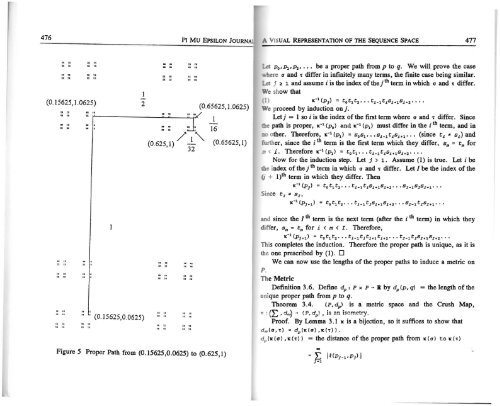Vol. 10 No 6 - Pi Mu Epsilon
Vol. 10 No 6 - Pi Mu Epsilon
Vol. 10 No 6 - Pi Mu Epsilon
- No tags were found...
Create successful ePaper yourself
Turn your PDF publications into a flip-book with our unique Google optimized e-Paper software.
476<br />
PI <strong>Mu</strong> EPSILON JOURN<br />
A VISUAL REPRESENTATION OF THE SEQUENCE SPACE 477<br />
= ..<br />
::I :&<br />
u :.s :a : s<br />
t& :1 = t:<br />
....<br />
u =<br />
(0.15625, 1.0625) 2 (0.65625, 1.0625)<br />
.. "<br />
...<br />
,. '<br />
.. ·r-------____;.;_;;__~<br />
"-:/<br />
I<br />
" . 16<br />
=" / .. 1 '""'<br />
(0.625,1) 32 (0.65625,1)<br />
p 0 ,p 11 p 2 , ••• be a proper path from p to q. We will prove the case<br />
re o and "'" differ in infinitely many terms, the finite case being similar.<br />
Ld j ~ 1 and assume i is the index ofthejth term in which o and "'" differ.<br />
We show that<br />
I) x-l(pj) = totlta'"tl-ltls.J•ls.J•:z" ..<br />
We proceed by induction on j.<br />
Let j = 1 so i is the index of the first term where o and 1: differ. Since<br />
path is proper, x- 1 (p 0<br />
) and x- 1 (p 1<br />
) must differ in the i th term, and in<br />
other. Therefore, x- 1 (p 1 ) = s 0 s 1 ••• s 1 _ 1 t 1 s 1 • 1 ••• (since t 1 ~ s 1 ) and<br />
further, since the i th term is the first term which they differ, sm = tm for<br />
< i. Therefore x- 1 (p 1<br />
) = t 0 t 1 • .. t 1 _ 1 t 1 s 1 • 1 s 1 • 2 .. ..<br />
<strong>No</strong>w for the induction step. Let j > 1. Assume (1) is true. Let i be<br />
the index of the j th term in which o and "'" differ. Let I be the index of the<br />
(j + l)th term in which they differ. Then<br />
x- 1 (pj) = t 0 t 1t 2 .•• t 1 _1tls.J. 1 s 1 • 2 ••• sx_ 1 SzSz•l''.<br />
Since tz ~ Sz,<br />
x- 1 (Pj. 1 ) = t 0t 1 t 2 ••• t.J_ 1t.Js 1 +1s 1 • 2 ••• sx_ 1 tzSz•l' ••<br />
rJ :s<br />
:: ! .1<br />
"<br />
(0.15625,0.0625)<br />
:z ~=<br />
:: ::<br />
u 1&<br />
u ~<br />
u n<br />
u :s<br />
n ::<br />
:: a<br />
Figure 5 Proper Path from (0.15625,0.0625) to (0.625,1)<br />
and since the I th term is the next term (after the i th term) in which they<br />
differ, sm = tm fori < m < I. Therefore,<br />
x-l (pj•l) = totlta. • • t.J-lt.Jt.J•lt.J+2' • • tx-ltzSz•lsi+'Z' • •<br />
This completes the induction. Therefore the proper path is unique, as it is<br />
the one prescribed by (1) . D<br />
We can now use the lengths of the proper paths to induce a metric on<br />
P.<br />
The Metric<br />
Definition 3.6. Define di> : P x P ~ R. by dP (p, q) = the length of the<br />
unique proper path from p to q.<br />
Theorem 3.4. (P, dP) is a metric space and the Crush Map,<br />
... : (L, d"') ~ (P, dP), is an h:ometry.<br />
Proof. By Lemma 3.1 x is a bijection, so it suffices to show that<br />
d.., (o,"t) = dP(x(o) ,1C(1:)).<br />
dP (x (a), 1t ("t)) = the distance of the proper path from 1t (o) to x ("t)<br />
·.
















